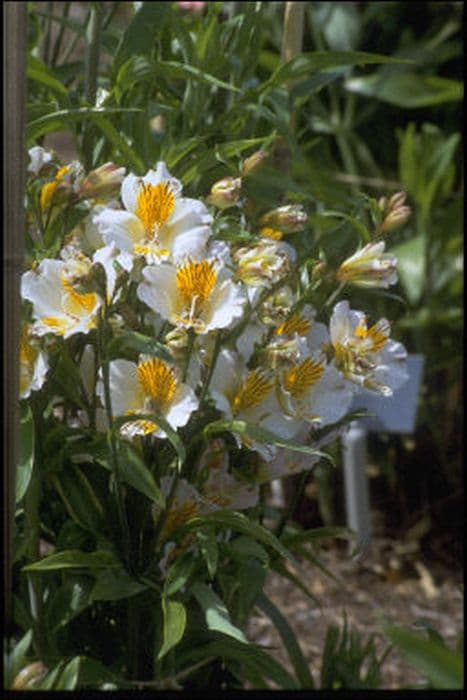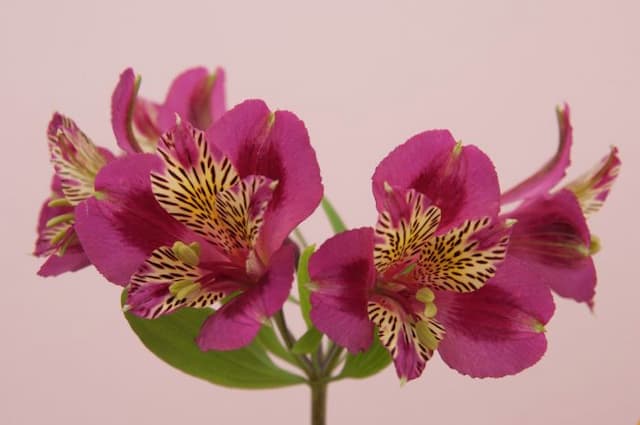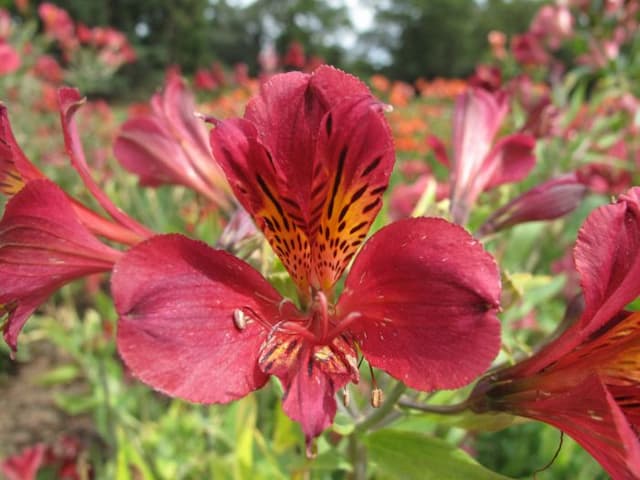Peruvian Lily Alstroemeria 'Friendship'

ABOUT
Alstroemeria 'Friendship', commonly known as Peruvian Lily or Lily of the Incas, exhibits a vibrant display of colors that can brighten up any garden space. The plant is traditionally recognized for its trumpet-shaped flowers with an exotic look reminiscent of tropical climates. These blossoms usually exhibit a striking blend of yellow and orange hues, creating a warm and inviting appearance. The petals of the Peruvian Lily 'Friendship' show intricate markings that can resemble delicate brush strokes or spots, which add to the plant's unique and ornamental quality. Inside the flower, one might notice streaks of darker colors that provide contrast and depth to the floral arrangement. Surrounding the showy flowers are slender, lance-shaped leaves that have a glossy texture. These leaves are often a rich, green color, creating a lush backdrop for the vividly colored flowers. The foliage can sometimes appear in clumps, adding to the overall density and fullness of the plant. The Peruvian Lily 'Friendship' is not only loved for its decorative flowers but also for its long vase life, making it a popular choice for cut flower arrangements. gardeners also favor this plant for its ability to attract pollinators, such as bees, which are drawn to the nectar-rich blooms. In conclusion, the Peruvian Lily 'Friendship' presents a dazzling combination of ornate flowers and graceful foliage that can contribute an element of cheerfulness and exotic beauty to any setting. Its long-lasting blooms, in warm shades of yellow and orange, are complemented by its attractive darkly-striped petals and lustrous green leaves.
About this plant
 Names
NamesFamily
Alstroemeriaceae
Synonyms
Peruvian Lily, Lily of the Incas, Parrot Lily, Peruvian Lily 'Friendship'
Common names
Alstroemeria 'Friendship'.
 Toxicity
ToxicityTo humans
The Alstroemeria, commonly known as the Peruvian lily or lily of the Incas, can cause mild toxicity if ingested. It might lead to nausea, vomiting, or diarrhea. The plant can also cause skin irritation due to its dermatitis-causing sap, so handle with care to avoid any potential allergic reactions. Care should be taken to keep this plant out of reach of children.
To pets
For pets, the Peruvian lily can be mildly toxic. If ingested, it could cause vomiting, diarrhea, or an overall upset stomach. It is particularly important to prevent cats and dogs from chewing on any part of the plant. While symptoms are often mild, it is recommended to contact your veterinarian if you suspect your pet has ingested this plant.
 Characteristics
CharacteristicsLife cycle
Perennials
Foliage type
Evergreen
Color of leaves
Green
Flower color
Mixed
Height
2-3 feet (60-90 cm)
Spread
1-2 feet (30-60 cm)
Plant type
Herb
Hardiness zones
7
Native area
South America
Benefits
 General Benefits
General Benefits- Long-lasting Blooms: Alstroemeria 'Friendship' flowers have a long vase life, making them excellent for cut flower arrangements.
- Attracts Pollinators: The vibrant flowers are known to attract bees, butterflies, and hummingbirds, promoting biodiversity in the garden.
- Drought Tolerance: Once established, this plant is relatively drought-tolerant, requiring less frequent watering and making it suitable for xeriscaping.
- Easy to Grow: It is generally easy to care for and does not require specialized skills, making it a good choice for amateur gardeners.
- Colorful Display: It produces a profusion of colorful and showy flowers, which can add aesthetic appeal to gardens and landscapes.
- Perennial Growth: As a perennial, Alstroemeria 'Friendship' returns each year, providing long-term value and reducing the need for annual replanting.
- Versatile Placement: It can thrive in borders, flower beds, and containers, offering flexibility in garden design and space utilization.
 Medical Properties
Medical PropertiesThis plant is not used for medical purposes.
 Air-purifying Qualities
Air-purifying QualitiesThis plant is not specifically known for air purifying qualities.
 Other Uses
Other Uses- Photography subjects: Alstroemeria, with its vibrant colors and unique patterns, is popular among photographers who specialize in botanical imagery, providing a striking subject for close-up photography.
- Crafting natural dyes: The pigments from the petals of Alstroemeria can be used to make natural dyes for textiles, offering an eco-friendly alternative to synthetic dyes.
- Educational tool: Due to its distinct flower structure, Alstroemeria can be used as a teaching aid in botany classes to illustrate plant anatomy and pollination strategies.
- Culinary decoration: Although not commonly known for its edibility, the petals of Alstroemeria can be used as a non-toxic decorative element for plating and garnishing in high-end culinary presentations.
- Art inspiration: The unique beauty of the Alstroemeria inspires artists for botanical illustration and can be used as a live model for painting and drawing.
- Perfumery: While not a traditional source for fragrances, the subtle scent of Alstroemeria can inspire the creation of exclusive perfumes.
- Floral art: Alstroemeria can be pressed and dried to create floral art pieces such as bookmarks, greeting cards, or framed botanical art.
- Theme gardens: Alstroemeria, named 'Friendship', can be used as the theme plant in a friendship garden, symbolizing lasting friendships and the bonds between individuals.
- Ice cubes: Petals of Alstroemeria can be frozen in ice cubes to add an elegant and colorful touch to drinks for special occasions.
- Seed harvesting: Hobbyist gardeners can collect seeds from Alstroemeria to learn about seed propagation and to experiment with growing the plant from seed to flower.
Interesting Facts
 Feng Shui
Feng ShuiAlstroemeria or Peruvian Lily can be used to enhance the friendship sector due to its common name 'Friendship'. In Feng Shui, it could be placed in the southwestern corner of your home or garden to attract good relationships and enhance harmony among friends, as this area is associated with love and relationships.
 Zodiac Sign Compitability
Zodiac Sign CompitabilityThe Peruvian Lily is not used in astrology practice.
 Plant Symbolism
Plant Symbolism- Friendship: As the common name 'Friendship' suggests, Alstroemeria is often associated with deep, long-lasting friendship. It represents the bonds and mutual support shared between friends.
- Devotion: Alstroemeria symbolizes the devotion and loyalty that friends share, showing a willingness to stand by each other through thick and thin.
- Strength: This plant can also signify the strength that each friend gives to the other, enabling both to endure tough times.
- Prosperity: Often connected with material wealth, Alstroemeria can indicate a wish for prosperity and success for a friend.
- Mutual Support: The intertwined growth pattern of the Alstroemeria's stems can represent mutual support and the interconnectedness between friends.
- Fortitude: The plant's resilience is seen as a symbol of the fortitude required to maintain a strong friendship.
 Water
WaterThe Peruvian Lily should be watered deeply until the water starts to run from the drainage holes, indicating that moisture has reached the entire root area. This usually equates to about 1 to 1.5 gallons for a mature plant in a large pot. During the growing season, in the absence of rainfall, watering once a week should suffice. In hot or windy climates, more frequent watering may be necessary, possibly twice a week. It's vital not to let the soil dry out completely, but also to avoid waterlogging as this can lead to root rot.
 Light
LightPeruvian Lilies thrive in bright, indirect light, making a spot that receives full morning sun and partial afternoon shade ideal. They can also adapt to full sun conditions in cooler climates. However, in very hot regions, protection from scorching afternoon sun is necessary to prevent leaf burn.
 Temperature
TemperaturePeruvian Lilies prefer a temperate climate and can tolerate a temperature range from about 40 to 80 degrees Fahrenheit. They can survive down to 28 degrees for short periods but consistently cold temperatures below freezing can damage the plant. The ideal temperature for their robust growth would be between 65 and 75 degrees Fahrenheit.
 Pruning
PruningPruning Peruvian Lilies is important for promoting vigorous growth and blooming. After the first killing frost in the fall or in early spring before new growth begins, cut back the entire plant to ground level. Deadheading spent flowers during the blooming season can also encourage more blooms. Frequent pruning isn't necessary; focus on these key times and any occasional removal of damaged or diseased stems.
 Cleaning
CleaningAs needed
 Soil
SoilPeruvian lily 'Friendship' thrives in fertile, well-drained soil with a pH between 6.5 and 7.5. A soil mix that is amended with compost or peat for organic content and some coarse sand or perlite for drainage makes the ideal growing medium.
 Repotting
RepottingPeruvian lily 'Friendship' typically requires repotting every two to three years or when it becomes root-bound.
 Humidity & Misting
Humidity & MistingPeruvian lily 'Friendship' does best in moderate humidity levels, typical of household environments, without the need for special humidifying techniques.
 Suitable locations
Suitable locationsIndoor
Place in bright, indirect light; avoid direct hot sun.
Outdoor
Plant in dappled sunlight, shelter from wind.
Hardiness zone
7-10 USDA
 Life cycle
Life cycleThe Alstroemeria 'Friendship', commonly known as the Peruvian lily or lily of the Incas, begins its life cycle when a seed germinates in warm, moist soil, typically in spring or early summer. The seedling stage follows, where the plant develops its first leaves and roots. As it matures into a vegetative stage, the Alstroemeria 'Friendship' establishes a strong root system and foliage, leading to the development of its distinctive, colorful flowers which usually bloom from late spring through early fall. After pollination, which is often aided by insects, the flowers will eventually wither and the plant will produce a capsule containing seeds, thus completing its reproductive stage. In the perennial phase, the plant enters dormancy during the colder months, with its underground rhizomes surviving to produce new growth in the following season. With proper care, this cycle can repeat for several years as the plant grows and multiplies through division of its rhizomes.
 Propogation
PropogationPropogation time
Spring-Early Summer
The Alstroemeria 'Friendship', commonly known as the Peruvian Lily or Lily of the Incas, is best propagated by division. This method involves separating the tuberous roots during the plant's dormancy period, which typically falls in late winter or early spring. Care should be taken to retain a portion of the crown with each division, ensuring that each new plant has at least one or two growing points. The divisions should be replanted immediately at the same depth they were growing previously, which is usually about 6 to 8 inches (15 to 20 centimeters) deep, spacing them about 12 to 24 inches (30 to 60 centimeters) apart to allow for adequate growth. Regular watering and a period of acclimation to their new location helps to establish the divisions, which will grow into new, flowering plants.






![Peruvian lily [Inca Coral]](/_next/image?url=https%3A%2F%2Fplants-admin.emdemapps.com%2Fimages%2Fplants%2F%2Fimages%2F604b5b79b85ce.png&w=640&q=75)
![Peruvian lily [Inca Exotica]](/_next/image?url=https%3A%2F%2Fplants-admin.emdemapps.com%2Fimages%2Fplants%2F%2Fimages%2F604b5ec0e34a9.png&w=640&q=75)
![Peruvian lily [Inca Milk]](/_next/image?url=https%3A%2F%2Fplants-admin.emdemapps.com%2Fimages%2Fplants%2F%2Fimages%2F604b5f14b0b6a.png&w=640&q=75)
![Peruvian lily [Inticancha White Pink Blush]](/_next/image?url=https%3A%2F%2Fplants-admin.emdemapps.com%2Fimages%2Fplants%2F%2Fimages%2F604b538014919.png&w=640&q=75)